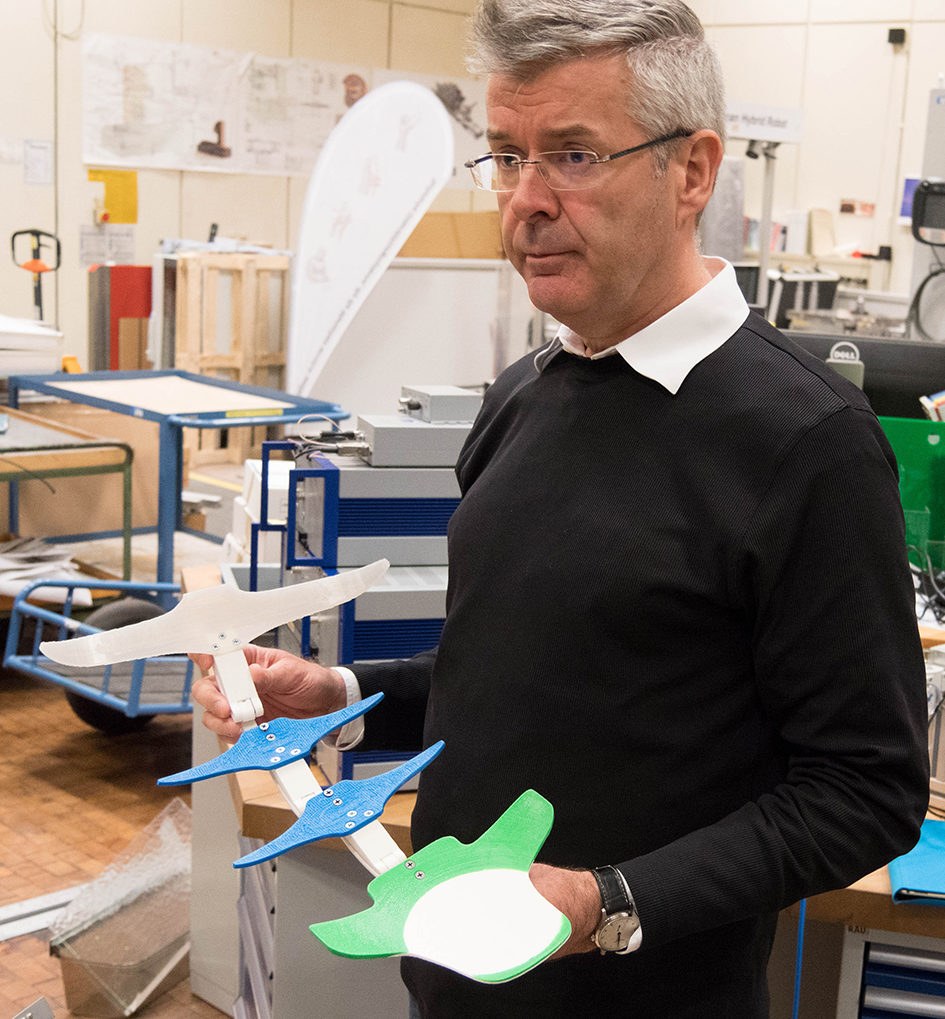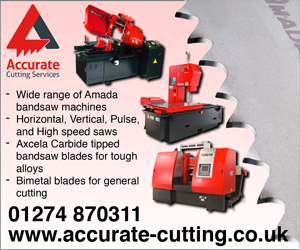EMO Hannover 2019: Exoskeletons relieving the strain
Notable regular guests at EMO Hannover include scientists who are there not only to pick up new ideas themselves, but also to inspire exhibitors with their work. Among these visitors is Prof. Jens P. Wulfsberg, who develops interdisciplinary technical support systems for production at the University of the Federal Armed Forces in Hamburg.
“OK, so what you’re talking about is ‘ergonomic’ weapon systems.” “That’s exciting – you’re turning Bundeswehr soldiers into Ironman.” These were typical comments from my friends when they heard that I was researching into “The development of exoskeletons” at the University of the Federal Armed Forces in Hamburg”. “The development work is not being carried out for the military,” explains Prof. Wulfsberg, head of the Laboratory of Production Engineering (LaFT) at Helmut Schmidt University in Hamburg, a few days later. Ergonomic Smart Assist aids are being developed at LaFT in an interdisciplinary team. According to a LaFT flyer, these are “technical support systems that people are really interested in”. More than 20 different exoskeletons have already been developed – from ankle orthoses to muscle gloves.
Exoskeletons should be affordable, portable and lightweight
“The aim of our exoskeletal systems is to help reduce workplace injuries,” explains sports scientist Andreas Argubi-Wollesen, senior biomechanic at the LaFT-Institut für Konstruktions- und Fertigungstechnik (LaFT Institute for Construction and Manufacturing Engineering). “Our systems are designed to take the muscular strain out of certain tasks and not to cause additional problems through their own weight.” The sociologist Dr. Athanasios Karafillidis is not only interested in the acceptance levels of the eventual wearers of the exoskeletons, he is also involved in developing related ideas and classifications. “It was not our intention to create a superhuman Ironman in the form of an exoskeleton,” emphasizes the deputy head of the Smart Assist working group. “The request was for an affordable, portable and easy-to-apply support system that features as little technology as possible.”
Facilitating overhead work
“We didn’t set out to create an exoskeleton. We were given the task of developing support components,” says the LaFT manager, looking back. “The first request came from the Airbus plant in Hamburg, which wanted to relieve the strain on its workers while carrying out overhead work.” The first functional models were tested there back in 2016. The main focus is on prevention, i.e. reducing the number of days lost to sickness, through the avoidance of overexertion. Actually creating such a system was initially difficult because no-one had any idea about the possibilities. The team set about the task in an interdisciplinary and pragmatic manner: it developed the first components, which it then tested directly on site. In order to reduce development times and costs, the Hanseatic researchers also apply the Lego principle in their work: the components should be modular and capable of being combined to form customised systems.
The researchers’ interdisciplinary “playground” is located in the basement of the university. Argubi-Wollesen demonstrates a jacket: “We are planning the use of intelligent clothing with individual support elements which are pneumatically stiffened under negative pressure. The garments relieve the wearer of the need to bear weight in certain positions.” Pneumatics, electric motors or memory alloys which deform when electrical voltage is applied, can be used as drives.
Acceptance plays an important role
Acceptance is important in all this. Some people welcome the systems as cool, high-tech gimmicks, while others reject them as crutches which supposedly make them look weak. Such reactions play a role, especially in conspicuous systems such as Lucy. Argubi-Wollesen helps me into the backpack-shaped exoskeleton. I raise my arms, it hisses – Lucy engages pneumatically to support the weight. I suddenly feel stronger and more powerful and realise that I can now hold a heavy object over my head for longer. I lower my arms, and the pneumatic assistance dissipates. “Lucy is a typical active system that is only deployed for specific applications,” explains the biomechanic. “We can adjust it individually so that it only activates in certain positions with individually adjustable force levels. When you reach for a smartphone or a tool, for example, it turns itself off.” This is because complete assumption of all work would result in weakening of the musculature and that is not the purpose of the support systems.
RFID sensors to detect tools
In order to develop practicable systems, the researchers examine typical work processes with the aid of sensors and so-called 3D motion caption systems. “This enables us to see how much muscular effort is involved in certain movements,” explains Argubi-Wollesen. “Then we test the exoskeleton to see how much support it gives the wearer. Laboratory tests with power support reveal an average of 20 to 30 per cent muscular relief. In practical measurements conducted at automobile manufacturers such as Ford, individual alleviation levels of up to 50 per cent have already been achieved with heavy tools.”
The system can now be adapted for specific applications such as drilling, grinding or milling. Karafillidis: “In the future, intelligent exoskeletons will presumably be able to detect the degree of individual strain directly via sensors and adapt the level of support accordingly.” However, the method also raises questions about data monitoring: what do we want to capture and what is allowed? “For us as ethical researchers, it is not acceptable to monitor employees in this way – nor is it legal. As with all modern technologies, there also needs to be social consensus on how to deal responsibly with the technological possibilities which this opens up,” continues Karafillidis.
The Hamburg researchers also have their sights set on machine assembly: Wulfsberg leads me to an assembly site where an internally developed small machine tool feed unit with two degrees of freedom driven by two piezo actuators is being assembled (travel range: 1.6 mm x 3.5 mm, accuracy: 1 µm). The drive element is intended for use in the construction of small machine tools required for “microproduction”, the manufacture of very small components such as those used in medical technology or the watch industry. The technician is assisted by movable elements that support his arms while he is working. These are tailor-made grip plates that LaFT produces by means of 3D printing. The Hamburg-based researchers use a robot to monitor the assembly processes. The robot’s sensors can be used to record the paths travelled and the forces. Wulfsberg: “We can use the recorded motion sequences to refine the assembly process.” Practical application in the field of medical technology is already planned.
Research at EMO Hannover 2019
The scientist is certain that support systems will become more important in the field of occupational health and safety in the future. In his capacity as an exoskeleton researcher, Wulfsberg is not only interested in systems for occupational safety at EMO Hannover 2019, but also in small machine tools for microproduction. After all, LaFT has already conducted research into “Small machine tools for small workpieces” in its DFG SPP1476 programme. Wulfsberg: “I am also keen to discuss the construction of small, inexpensive machine tools for microproduction with manufacturers in Hanover. So it will be interesting for me to visit manufacturers of micro machining centres, for example.” This is certainly a possibility, as the EMO homepage currently lists 20 manufacturers in the category “micromachining centres”. Chiron, Benzinger, Datron, Fehlmann, GF Machining, Hermle, Kern, Kummer, Schaublin Machines, Sodick Willemin-Macodel and Yasda are some of the possible candidates.





